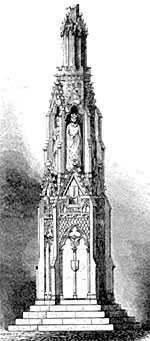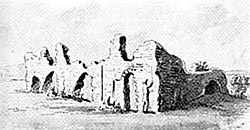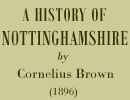< Previous | Contents | Next >
Harby and Broadholme

Charing Cross London: the last of the line of Eleanor Crosses between Lincoln and London.
ON the borders of Nottinghamshire and Lincolnshire, as you approach the cathedral city, is the village of Harby, and in its beautiful new church there is a brass in the floor of the chancel which bears this inscription: ‘Here died Eleanor of Castile, Queen of England, Nov. 27th, A.D. 1290.’ The little chapel of one aisle mentioned by Throsby, which stood close to the new church, was a small building of stone, with massive walls. In the field adjoining the churchyard are the remains of a moat, and the tradition is that it was on this spot the house stood in which the good Queen died.
In the reign of Edward I., Richard de Weston had free warren at Harby, and for some considerable time the family of Weston were owners of the place conjointly with the Bishops of Lincoln. A Sir John Weston was employed in the royal service in Edward’s time, and it may have been because he stood high in favour that, when Queen Eleanor came with her consort to this county, the house at Harby, belonging to Richard de Weston, was selected as the place of her abode. It was on September I I, 1290, that their Majesties arrived at Harby. As the Queen was unwell, suffering from a slow fever (Wikes says, ‘Modicae febris igniculo contabescens’), she would probably remain in the quietude of Harby while the King proceeded to hold his Court at Clipstone, and to pay visits to other houses in the locality.
From the 13th to the 17th September his Majesty was at Newstead, and on the 18th and 19th at Rufford, and on the 22nd at his own house at Clipstone, of which some portion of the ruins still remain.
The Parliament was summoned to meet at Clipstone on October 27, and prior to its assembly the King enjoyed himself in field sports, for which the district was famous. The Parliament sat at Clipstone till November 13, and very important would be the business that came before it, for the dispute as to the Scotch succession had arisen, and Edward was trying to shape the strife towards his own ends. On November 14 the King had reached Laxton, where the writs were tested for several days, and was moving towards Harby. The Queen meanwhile continued unwell, but we may be sure no immediate danger was apprehended, or the King, who was a most devoted husband, would not have left her. On October 18, syrups and medicines had been brought for her use from Lincoln, for there is an entry of the payment of 13s. 4d. for physic to one Henry de Montepessulano. When the King reached Harby on the 20th, grave symptoms had developed. So dangerously ill had the Queen become that it was impossible for them to continue their journey. A physician from her native country had arrived, and spiritual advisers had been sent for to administer consolation. Sir Garcia de Ispania brought her a cross, and to the physician of the King of Aragon, who had come to attend her, the Queen presented a silver goblet.

The ruins of Clipstone Palace as recorded by Samuel Hieronymus Grimm in 1775.
What a mournful gathering it was in those dull November days in that house of Richard de Weston, A.D. 1290! There lay the suffering Queen with life ebbing slowly away, and by her bedside the sorrowing husband, whom she had accompanied in the crusades, and whose fortunes she had loyally and lovingly shared for thirty-five years. A career begun in Spain, and characterized by all that was noble and creditable—a career of great service to England from her betrothal at the age of ten to her joyous landing, when ‘the fountains spouted wine, and the windows rained gold'—was coming to a close in a little Nottinghamshire village. The tall stalwart monarch, beloved of his people, the object of almost boundless admiration, who had been crowned with her amidst a scene of great magnificence, was bidding her a sad farewell in the little house of a country squire, far away from the busy haunts of men, in a secluded part of a quiet country district. From the 20th to the 27th, the King so far attended to business as to sign writs, and then the entries cease. On the evening of the 27th the Queen breathed her last, and her consort in the midst of his great grief had no thought for State affairs for some days to come. His anxiety was to pay every possible honour to her memory. ‘I loved her tenderly in her lifetime,’ he wrote to her friend, the Abbot of Clugny, ‘and I do not cease to love her now she is dead.’ Writing on the day of her death to Archbishop Romanus, he desired the prayers of the faithful for the soul of Queen Eleanor, ‘our wife from our childhood,’ and the Archbishop at once granted an indulgence of forty days for those who should pray for the Queen’s soul. The Chapter of York ordered a full peal to be rung when they heard the sad news, and there were sincere manifestations of mourning throughout the country.
After her death costly memorials were erected to her memory. At Harby ample provision was made by the Queen’s will for the perpetual celebration of memorial services. A hundred marks were placed in the hands of the Dean of Lincoln in 1292 for the purpose of founding a chantry. Gough says that the Prebendary of North Clifton was to receive ten marks yearly, out of which he was to pay 100s. a year to the chantry priest and to find him a lodging, and also to provide furniture for the altar. In the ‘Valor Ecclesiasticus’ it is mentioned that the annual stipend then was 103s. The entry is as follows: ‘Cantaria de Herbe, Thomas Kyllyall, Chantrey priest. Having a mansion wt a garden of the yerely value of iiijs. in money paid to him by the Prebend of Clyfton Cs Sma. of th’ole and clere value ciijs.’ The payment would come to an end 1 Edward VI., when an Act was passed by which chantries were suppressed throughout the country. For nearly three centuries no observance or memorial commemorated Queen Eleanor at Harby, but the tradition of a Queen having been at the village still lingered. Throsby says ‘the inhabitants have a simple tradition that a Queen Catherine resided ages since at this place,’ though how the name of Catherine came to be substituted for Eleanor, it is difficult to imagine. All doubts as to the identity of the royal personage whose name is associated with Harby are now dispelled, and the appropriate memorials in monumental brass and sculptured stone with which the new church is adorned will long remain to remind residents and visitors that the sacred edifice stands on famous ground. [A statue of the Queen, which stands outside the building in a niche over the door at the east end, was given by Mr. Freeth, an antiquary of cultured tastes and never-failing kindness and liberality.]
There are two railway-stations almost equidistant from Harby, those of Thorpe and Saxilby, each about four miles off. On the way to the latter the fine broad road passes through the hamlet of Broadholme, which consists of about a dozen houses; but it must always be a place of interest as the site of one of the earliest nunneries founded in this country. A short distance from the main road there is a large farmstead known as the Manor Farm. On this spot, now covered by a modern house, with its spacious outbuildings and farmyard, there was in the reign of King Stephen a house of Premonstratensian nuns founded by Agnes de Camville, wife of Peter de Gousla, who introduced the order into England about A.D. 1140.
Camville was a name of note in Lincolnshire. Gerard de Camville was sheriff of the county, and constable of Lincoln Castle; while his widow, Nicholas, afterwards defended the castle bravely and successfully for King John against the insurgent barons. A well-informed local writer says that Brodholme would at this period of its history ‘be slightly raised above the surrounding swamps in which the flood waters of the Trent, unrestrained by artificial banks, would mingle with those of the Witham, and possibly to the pious mind of the foundress the seclusion of the spot and its level grassy surface may have presented a fancied resemblance to the original Pre Montre, the meadow miraculously pointed out as the fitting site of a religious order.’[Article on Brodholme in the Deanery of Graffoe Parish Magazine]. In this isolated abode a prioress and nuns continued to reside for several centuries, the calm and even tenor of their monastic life only broken, so far as we know, on one occasion when a sister was forcibly abducted. The outrage took place in the reign of Edward III., A.D. 1350, and is thus described in a manuscript in the British Museum. ‘William Fox, parson of Lee, near Gainsborough, John Fox and Thomas de Lingeston, Friars Minor of the convent in Lincoln, were indicted before Gilbert de Umfravill and other justices of the parts of Lindsey, at Thwacaster; on the Saturday after the feast of St. John the Baptist in the said year, for that they came to the nunnery of Brodholme, in the county of Nottingham, and then and there ("rapuerunt et abduxerunt inde, contra pacem Di Regis," etc.) violently took and forcibly carried away, a certain nun by name Margaret de Everingham, a sister of the said house, stripping her of her religious habit and putting upon her a green gown or robe of the secular fashion.’ They were also charged with taking away divers goods to the value of 40s. What punishment was inflicted on the offenders, the record does not say. The nunnery must have been strangely agitated at this violent intrusion, and it could ill afford to lose any of its goods, for it was not richly endowed, its annual income being in the time of Henry VIII. only £16 5s. 2d.
The farmhouse which now occupies the site is largely built of the old stone which formed part of the nunnery. Over the front door is a square fragment bearing a plain shield, and carved with running foliage, while other portions of stone evidently formed parts of the arches and mullions of windows. The moat which surrounded the house remains, and relics have been dug up which give a clue to the situation of the various parts of the establishment. In the grass fields are traces of the fish ponds, and where is now a copse there was formerly a duck decoy. The field in which the mill stood is still known as the mill field, and two of the millstones are on the premises, one of them forming a slab near the kitchen door. Foundation walls have been discovered, showing that the chapel stood at the back of the present house, and a stone coffin was dug up which is now at Doddington, and which was probably that of some influential personage who was buried before the high altar. The ordinary burial-place was in the paddock, now used as an orchard.
